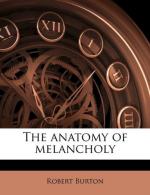MEMB. V.
SUBSECT. 1.—Cure of Love-Melancholy, by Labour, Diet, Physic, Fasting, &c.
Although it be controverted by some, whether love-melancholy may be cured, because it is so irresistible and violent a passion; for as you know,
[5601] ------“facilis descensus Averni; Sed revocare gradum, superasque evadere ad auras; Hic labor, hoc opus est.”------
“It
is an easy passage down to hell,
But
to come back, once there, you cannot well.”
Yet without question, if it be taken in time, it may be helped, and by many good remedies amended. Avicenna, lib. 3. Fen. cap. 23. et 24. sets down seven compendious ways how this malady may be eased, altered, and expelled. Savanarola 9. principal observations, Jason Pratensis prescribes eight rules besides physic, how this passion may be tamed, Laurentius 2. main precepts, Arnoldus, Valleriola, Montaltus, Hildesheim, Langius, and others inform us otherwise, and yet all tending to, the same purpose. The sum of which I will briefly epitomise, (for I light my candle from their torches) and enlarge again upon occasion, as shall seem best to me, and that after mine own method. The first rule to be observed in this stubborn and unbridled passion, is exercise and diet. It is an old and well-known, sentence, Sine Cerere et Saccho friget Venus (love grows cool without bread and wine). As an [5602]idle sedentary life, liberal feeding, are great causes of it, so the opposite, labour, slender and sparing diet, with continual business, are the best and most ordinary means to prevent it.
“Otio
si tollas, periere Cupidinis artes,
Contemptaeque
jacent, et sine luce faces.”
“Take
idleness away, and put to flight
Are
Cupid’s arts, his torches give no light.”
Minerva, Diana, Vesta, and the nine Muses were not enamoured at all, because they never were idle.
[5603] “Frustra blanditae appulistis ad has,
Frustra
nequitiae venistis ad has,
Frustra
delitiae obsidebitis has,
Frustra
has illecebrae, et procacitates,
Et
suspiria, et oscula, et susurri,
Et
quisquis male sana corda amantum
Blandis
ebria fascinat venenis.”
“In
vain are all your flatteries,
In
vain are all your knaveries,
Delights,
deceits, procacities,
Sighs,
kisses, and conspiracies,
And
whate’er is done by art,
To
bewitch a lover’s heart.”
’Tis in vain to set upon those that are busy. ’Tis Savanarola’s third rule, Occupari in multis et magnis negotiis, and Avicenna’s precept, cap. 24. [5604]_Cedit amor rebus; res, age tutus eris_. To be busy still, and as [5605]Guianerius enjoins, about matters of great moment, if it may be. [5606]Magninus adds, “Never to be idle but at the hours of sleep.”




